
Jules Sébastien César Dumont d'Urville was a French explorer and naval officer who explored the south and western Pacific, Australia, New Zealand, and Antarctica. As a botanist and cartographer, he gave his name to several seaweeds, plants and shrubs, and places such as d'Urville Island in New Zealand.

Jean Baptiste Alphonse Déchauffour de Boisduval was a French lepidopterist, botanist, and physician.
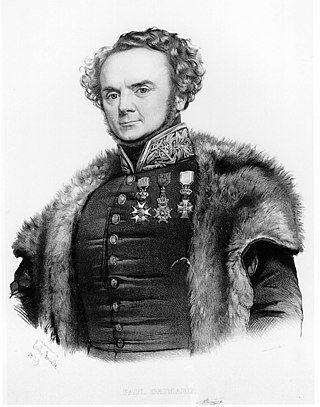
Joseph Paul Gaimard was a French naval surgeon and naturalist.

Jean René Constant Quoy was a French naval surgeon, zoologist and anatomist.
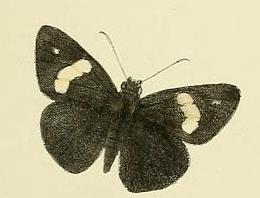
Notocrypta feisthamelii, the spotted demon, is an Indomalayan butterfly belonging to the family Hesperiidae. The name honours the French entomologist Joachim François Philibert Feisthamel.
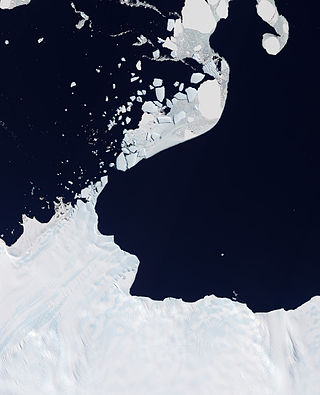
Astrolabe Glacier is a glacier 10 kilometres (10 km) wide and 19 kilometres (10 nmi) long, flowing north-northeast from the continental ice and terminating at the coast in a prominent tongue at the east side of Geologie Archipelago. It was first sighted in 1840 by the French expedition under Captain Jules Dumont d'Urville, although no glaciers were noted on d'Urville's chart of this coast but a formidable icy dike with perpendicular flanks of 37.7 m high according to the joined plate, corresponding to the glacier tongue. The glacier was photographed from the air by U.S. Navy Operation Highjump in January 1947. It was charted by the French Antarctic Expedition, 1949–51, and named after d'Urville's flagship, the Astrolabe.

The hooded monarch is a species of bird in the family Monarchidae. It is found on New Guinea. Its natural habitat is subtropical or tropical moist lowland forests.
Débarquement Rock is an ice-free rock 200 metres (220 yd) long and 18.7 m high, marking the northern end of the Dumoulin Islands and the north-eastern end of the Geologie Archipelago.
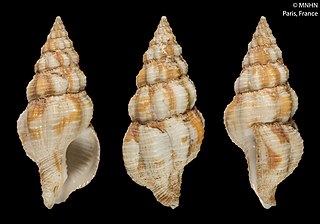
Latirus maculatus is a species of sea snail, a marine gastropod mollusc in the family Fasciolariidae, the spindle snails, the tulip snails and their allies.

Nassarius margaritifer is a species of sea snail, a marine gastropod mollusk in the family Nassariidae, the Nassa mud snails or dog whelks.
Teanu is the main language spoken on the island of Vanikoro, in the easternmost province of the Solomon Islands.

The palmflies are a common Asian butterfly genus found from India to the Solomon Islands. The caterpillars mimic leaves which they feed on. The adults mimic certain species.
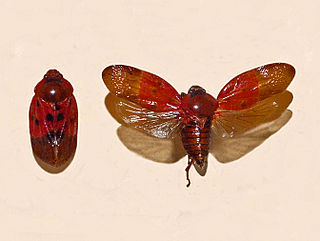
Leptataspis discolor is a species of froghoppers belonging to the family Cercopidae.
Botryllus elegans is a species of colonial ascidian tunicates in the family Styelidae. It is found in Mozambique and South Africa.

Delias gabia is a butterfly in the family Pieridae. It was described by Jean Baptiste Boisduval in 1832. It is endemic to New Guinea.
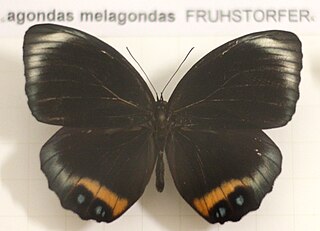
Elymnias agondas, the palmfly, is a butterfly in the family Nymphalidae. It was described by Jean Baptiste Boisduval in 1832. It is endemic to New Guinea and neighbouring Cape York in the Australasian realm.

Idea durvillei is a large butterfly that belongs to the danaid group of the family Nymphalidae. It was described by Jean Baptiste Boisduval in 1832. It is found in the Australasian realm. The name honours Jules Dumont d'Urville.

Lamprolina aeneipennis is an Australian beetle species in the family of leaf beetles (Chrysomelidae), which is found in eastern Australia, in Queensland, New South Wales and Victoria, but in New South Wales only. It was first described in 1835 by Boisduval as Phyllocharis aeneipennis.

Dicranolaius bellulus is a species of soft-winged flower beetle in the family Melyridae, found in Australia, in all mainland states and territories. It was first (partially) described in 1830 by Félix Édouard Guérin-Méneville as Malachius bellulus with the publication of illustrations. However, Guérin-Méneville completed the description with the publication of a text in 1838. Consequently, the Australian Faunal Directory considers the first valid publication to be that of Jean Baptiste Boisduval in 1835. Taxonomic reasons for the various synonyms are given in a 2017 paper by Liu, Slipinski and Pang.















